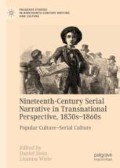Abstract
G.W.M. Reynolds’s The Mysteries of London is a prominent example of mid-nineteenth-century commercial mass culture not only in its mediated and distributed form but also in its mediated content. To illustrate the fundamental changes brought about by industrialization, Reynolds employs multi-media strategies to explore and capitalize on the complexity of cultural and economic agency in the Victorian cultural industry. Moreover, his use of media in The Mysteries of London offers a useful lens through which to contemplate the narrative and aesthetic strategies of contemporary quality television series.
Access this chapter
Tax calculation will be finalised at checkout
Purchases are for personal use only
Notes
- 1.
The actor Harold Lloyd “is the great-great-great-grandson of Charles Dickens” (“The Boy”). His character in the series dies in episode 6 of the first season.
- 2.
For a detailed overview on this topic, see Weber, Kultivierung, chapter 6.
- 3.
Unless otherwise indicated, quotations are from Volume 1 of the Vickers edition of The Mysteries of London (1845).
- 4.
Other female figures, such as Isabella, are branded with the label of virtue and therefore have no further character trait. Isabella is portrayed as an empty icon whose purity is absolute, and the virtue makes her incapable of acting. Virtuosity goes hand in hand with passivity (cf. Thomas, “Introduction” xvi).
Works Cited
Barthes, Roland. 1981. Camera Lucida: Reflections on Photography. 1980. Translated by Ruchard Howard. New York: Hill and Wang.
Caldwell, John Thornton. 1995. Televisuality: Style, Crisis, and Authority in American Television. New Brunswick, NJ: Rutgers University Press.
Chevasco, Berry Palmer. 2003. Mysterymania: The Reception of Eugène Sue in Britain 1838–1860. Oxford: Lang.
Crary, Jonathan. 1992. Techniques of the Observer: On Vision and Modernity in the Nineteenth Century. Cambridge, MA: MIT Press.
Davis, Tracy C. 1988. Actresses and Prostitutes in Victorian London. Theatre Research International 13 (3): 221–34.
Edler, Erich. 1932. Eugène Sue und die deutsche Mysterienliteratur. Berlin-Neukölln: Rother.
Game of Thrones. US 2011–2019. David Benioff, D.B. Weiss, HBO.
Hagedorn, Roger. 1988. Technology and Economic Exploitation: The Serial as a Form of Narrative Presentation. Wide Angle 10 (4): 4–12.
———. 1995. Doubtless to Be Continued: A Brief History of Serial Narrative. In To Be Continued… Soap Operas Around the World, ed. Robert C. Allen, 27–48. London: Routledge.
Hügel, Hans-Otto. 2007. Lob des Mainstreams: Zu Begriff und Geschichte von Unterhaltung und Populärer Kultur. Cologne: von Halem.
Humpherys, Anne. 1983. G.W.M. Reynolds: Popular Literature & Popular Politics. Victorian Periodicals Review 16 (3/4): 79–89.
———. 1991. Generic Strands and Urban Twists: The Victorian Mysteries Novel. Victorian Studies 34 (4): 455–72.
John, Juliet. 2008. Reynolds’s Mysteries and Popular Culture. In G.W.M. Reynolds: Nineteenth-Century Fiction, Politics, and the Press, ed. Anne Humpherys and Louis James, 163–77. Aldershot: Ashgate.
Kämmerlings, Richard. 2010. The Wire: Ein Balzac für unsere Zeit. Faz.net, 14 May.
King, Andrew. 2004. The London Journal, 1845–83: Periodicals, Production and Gender. Aldershot: Ashgate.
Klemperer, Victor. 1927. Preface to Eugène Sue: Die Geheimnisse von Paris, 7–11. Berlin: Voegels.
Leverette, Marc. 2008. Cocksucker, Motherfucker, Tits. In It’s Not TV: Watching HBO in the Post-Television Era, ed. Marc Leverette, Brian L. Ott, and Cara Louise Buckley, 123–51. London: Routledge.
Maidment, Brian. 2008. The Mysteries of Reading: Text and Illustration on the Fiction of G.W.M. Reynolds. In G.W.M. Reynolds: Nineteenth-Century Fiction, Politics, and the Press, ed. Anne Humpherys and Louis James, 227–46. Aldershot: Ashgate.
Miami Vice. US 1984–1990. Anthony Yerkovich, NBC.
Mittell, Jason. 2015. Complex Television: The Poetics of Contemporary Television Storytelling. New York: New York University Press.
Mulvey, Laura. 2010. Visual Pleasure and Narrative Cinema. 1975. In The Film Theory Reader: Debates and Arguments, ed. Marc Furstenau, 200–08. London: Routledge.
Reynolds, G.W.M. 1845. The Mysteries of London. Vol. 1. London: Vickers.
———. 1846. The Mysteries of London. Vol. 2. London: Vickers.
———. 1996. The Mysteries of London. 1844–1846. Edited and introduction by Thomas Trefor. Keele: Keele University Press.
Sue, Eugène. 2015. The Mysteries of Paris. 1842–1843. Translated by Carolyn Betensky and Jonathan Loesberg. New York: Penguin.
The Boy with Dickens in his Blood—Harry Lloyd. 2011. Evening Standard, 21 December.
The Sopranos. US 1999–2007. David Chase, HBO.
The Wire. US 2002–2008. David Simon, Ed Burns, HBO.
Thomas, Trefor. 1996. G.W.M. Reynolds’s The Mysteries of London: An Introduction. In G.W.M. Reynolds: The Mysteries of London, ed. and introduction by Thomas Trefor, vii–xxiv. Keele: Keele University Press.
———. 2002. Rereading G.W. Reynolds’s The Mysteries of London. In Rereading Victorian Fiction, ed. Alice Jenkins and Juliet John, 2nd ed., 59–80. Basingstoke: Palgrave Macmillan.
Thompson, Robert J. 1996. Television’s Second Golden Age: From Hill Street Blues to ER. London: Continuum.
Weber, Tanja. 2012. Kultivierung in Serie: Kulturelle Adaptionsstrategien von fiktionalen Fernsehserien. Marburg: Schüren.
———. 2016. Un-/endliche Geheimnisse: Die kulturellen Adaptionen von Sues Les Mystères de Paris. In Bruch und Ende im seriellen Erzählen, ed. Birgit Wagner, 45–69. Göttingen: Vandenhoeck & Ruprecht.
Yacovar, Maurice. 2003. The Sopranos on the Couch: Analyzing Television’s Greatest Series. 4th ed. London: Continuum.
Author information
Authors and Affiliations
Corresponding author
Editor information
Editors and Affiliations
Rights and permissions
Copyright information
© 2019 The Author(s)
About this chapter
Cite this chapter
Weber, T. (2019). The Media Mysteries of London. In: Stein, D., Wiele, L. (eds) Nineteenth-Century Serial Narrative in Transnational Perspective, 1830s−1860s. Palgrave Studies in Nineteenth-Century Writing and Culture. Palgrave Macmillan, Cham. https://doi.org/10.1007/978-3-030-15895-8_12
Download citation
DOI: https://doi.org/10.1007/978-3-030-15895-8_12
Published:
Publisher Name: Palgrave Macmillan, Cham
Print ISBN: 978-3-030-15894-1
Online ISBN: 978-3-030-15895-8
eBook Packages: Literature, Cultural and Media StudiesLiterature, Cultural and Media Studies (R0)

